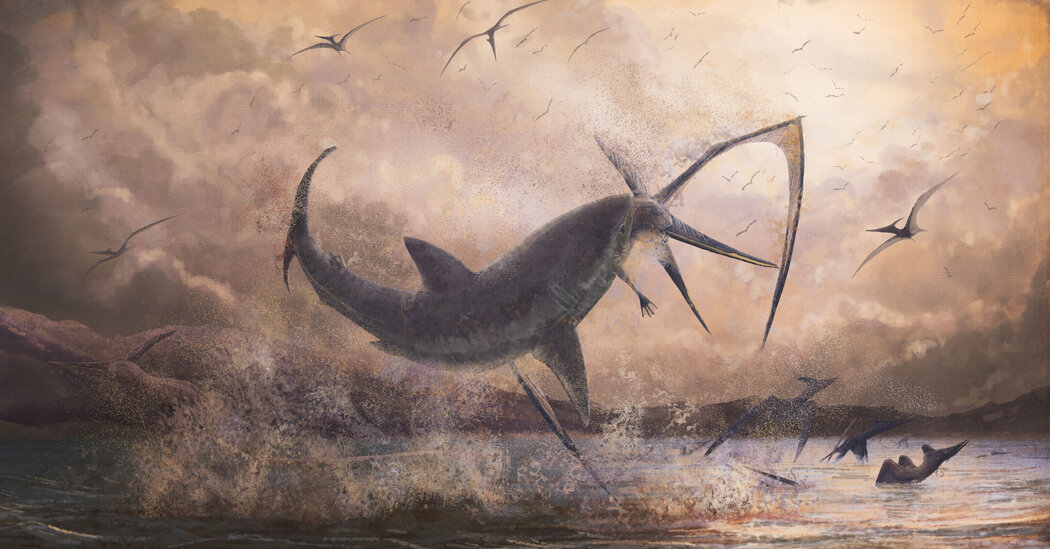It sounds like something out of a Hollywood movie script, but it actually happened: Shark evolution researchers say rising ocean temperatures more than 100 million years ago may have allowed sharks to grow bigger, swim faster and become the powerful predators we know today.
In a paper Published last month in the journal Current Biology, scientists reported that they measured the fin sizes and body lengths of 500 extinct and living sharks and compared that information with data from the shark evolutionary tree. Their results suggest that when the ocean became very warm during the Cretaceous period about 122 million years ago, some sharks left their seafloor habitat and moved into the open ocean. That surge may have altered their fin and body structure, leading to changes in their size and swimming ability.
It’s a misconception that all sharks resemble the bloodthirsty, powerful, streamlined beasts from “Jaws” that swim near the surface of the ocean (or in tornadoes and city streets, if you’ve seen “Sharknado.”) Most sharks have always been benthic, meaning they’re bottom feeders. Unlike their pelagic — or open-water — cousins, benthic sharks don’t have to swim constantly to breathe. They can rest on the seafloor.
However, the need to breathe may have been the trigger for some sharks to move higher in the water column. The authors suggest that the bottom of the Cretaceous ocean was becoming increasingly oxygen-poor in some places. To survive and eventually thrive, it was time to leave the seafloor.
Evidence of this shift in habitat and what persisted in which environment can be seen in the changing pectoral fins of ancient pelagic and benthic sharks.
“Most sharks that live in open water have elongated fins, while bottom-dwelling sharks have blunter fins,” said Lars Schmitz, a professor of biology at Claremont McKenna College in California, who is one of the paper’s authors.
His co-author Phillip Sternes, a shark researcher from California, compared pectoral fins to airplane wings. “Long, narrow wings” — like those on a commercial jet, for example — “help your lift-to-drag ratio, so it lowers your fuel costs,” he said. In contrast, “the short, stubby wings of fighter jets aren’t good for long distances, but they can turn on the fly.”
The same goes for sharks: longer pectoral fins may have allowed larger sharks to swim more efficiently, an important adaptation for species that now had to swim constantly to breathe.
But it’s not just body and fin size that may have increased. The Cretaceous’ peak ocean surface temperature of about 83 degrees Fahrenheit may have affected the sharks’ speed. (For comparison, today’s average is 68 degrees.)
Sharks and other fish are like most animals, explained Timothy Higham, a study co-author and professor at the University of California, Riverside, “in that muscle function is very dependent on temperature.” In other words, he said, “as your muscles warm up, they get better at contracting quickly.”
Higher temperatures and faster, more agile muscles allowed sharks to “flick their tails back and forth faster,” he said. That translates to higher speed, which, he added, could have led to sharks “expanding into more open-water habitat,” catching fast-swimming prey and avoiding other Cretaceous marine predators that are now extinct.
That all sounds promising. As ocean temperatures rise due to global warming, could we see similar changes in today’s sharks? In other words, could sharks grow even bigger and faster?
Global warming millions of years ago may have triggered important evolutionary adaptations in some sharks, but Dr Higham stressed that today’s rapidly changing climate is more likely to harm ocean life.
“Because other animals, non-shark organisms, were completely destroyed,” he said, adding that while some sharks adapted to the Cretaceous oceans, “it also caused a lot of other animals to go extinct.”
Allison Bronson, a faculty member at California State Polytechnic University in Humboldt who was not involved in the study, agreed.
“The spread of marine anoxic zones and changes in global climate, often concurrent with ocean acidification, have led to the worst mass extinctions in Earth’s history,” she said, adding that “the pace of change is now truly unprecedented.”


